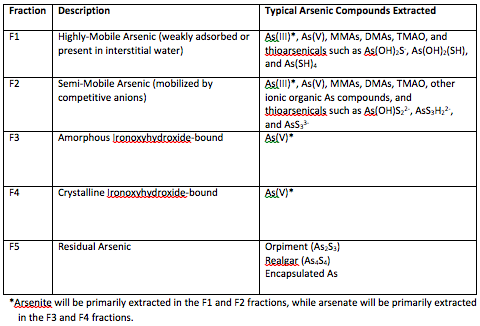 It has become increasingly common for risk assessment and treatability studies to require arsenic speciation data to determine the potential mobility of this toxic contaminant at varying sites.
It has become increasingly common for risk assessment and treatability studies to require arsenic speciation data to determine the potential mobility of this toxic contaminant at varying sites.
Looking at arsenite [As(III)] and arsenate [As(V)] values can be helpful for these studies; however, this approach can only provide a snapshot of how much arsenic is readily leachable at any given time. In situ, the conditions in soil and sediment samples can change over time depending on many factors, including the amount of rainfall, contaminant plume movement, and the hydrogeology at each individual site. Arsenic trapped in various mineral phases can be mobilized under varying site conditions, and even the treatment technologies used to remediate a site can affect the chemistry of the targeted environment and the subsequent arsenic lability.
At Brooks Rand Labs (BRL), we have a proprietary procedure for the selective sequential extraction of groups of arsenic species in soluble, adsorbed, and precipitated forms of arsenic compounds in soils, sediments, and similar solid matrices using a series of solutions with an increasing ability to solubilize and extract the solid-phase arsenic. Rather than identify specific arsenic species, the arsenic is fractionated in accordance with its interaction with iron oxyhydroxides, manganese oxyhydroxides, aluminum oxides, and other substrate components. The applied extraction solutions are designed to target the different substrate components and stabilize the respective arsenic species within each of the defined fractions below. The typical arsenic compounds listed for each fraction are only representative of how the method can perform and will fluctuate with different sites and conditions.

The BRL arsenic sequential extraction method accompanied by analysis of each fraction for total arsenic and other elements can be a powerful tool to help predict how much arsenic will be mobilized under different conditions. This type of information can be of enormous value for modeling, risk assessment, and design/engineering of treatment technologies.
If you would like more information about the selective sequential extraction procedure for arsenic speciation and whether it would be appropriate for your project, please contact us.

What procedures in published papers are you using for the sequential extraction of arsenic?
I am trying to develop a arsenic speciation method for spices. I have tried numerous extraction techniques, but my recoveries are still low. I know many of the spices with high total As are contaminated with soil. This is why I would like some more information on your sequential extraction of arsenic in soil. Thank you for your time.